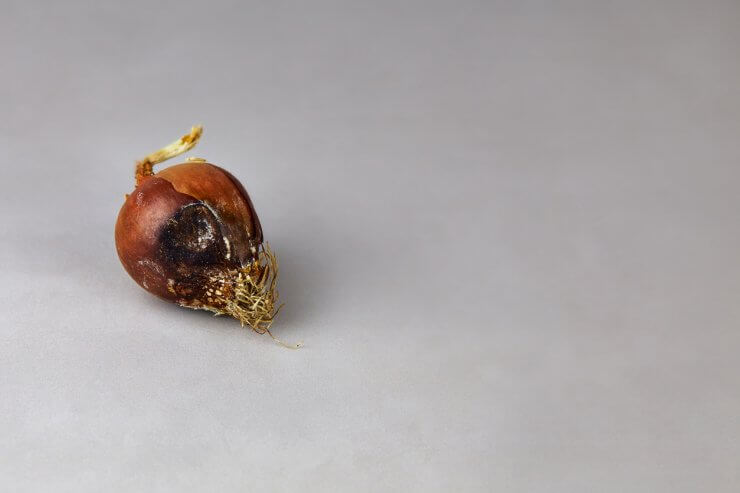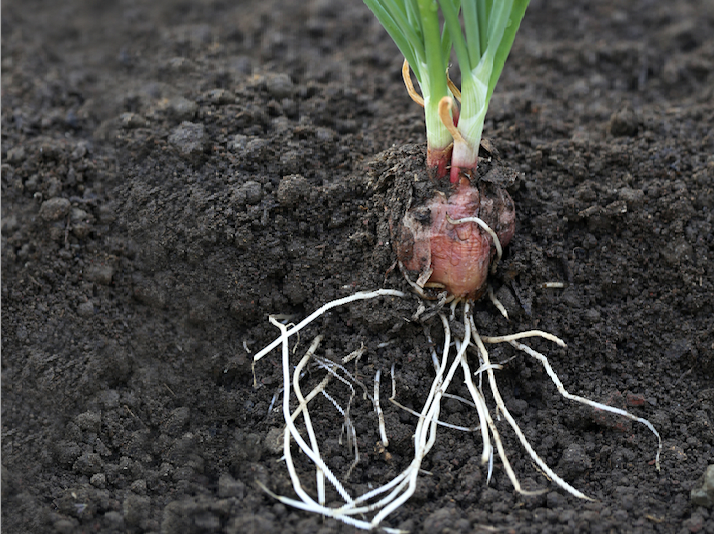
Bulb rot in young onion
Bulb rot is by far the worst of the diseases that can affect onions; once infected, your plant is likely lost. But there are steps you can take to prevent rot from taking hold of your onions.
Some bulb rot starts while your onions are growing, during harvest, or in storage:
- Onion soft rot
- Onion pythium rot
- Onion basal plate rot
Other rots take hold when your onions are in storage:
- Onion botrytis, aka neck rot
- Onion mush rot
What does bulb rot look like?
The onion bulb may look squishy and brown—totally unappealing and inedible. During the early phases of some rots, the plants will appear to wilt during the day but recover in the evening. But eventually, you’ll see water-soaked lesion on the lower stems and on the bulbs.
You may also notice the leaves start to yellow and die back. In some cases, you may notice creeping rot coming up from the root end of the bulb.
What causes bulb rot in onions?
In all the above cases except for soft rot, which is caused by bacteria, these onion rots are caused by fungal diseases that can live in the ground for years. Onion soft rot is caused by several types of bacteria, and most commonly affects onions in storage. If onions are damaged during harvest, the bacteria can infect them. It starts at the neck and works its way into the bulb of the onion until you have a watery, smelly mess.
If you have an extended period of rain, that could put your plants at risk, especially if you have hot days and warm nights. The fungi can live on plant debris and in weed roots; it’s possible to spread an infection by overwatering (or exposure to a lot of rain).
How can you control and treat root rot and other onion ailments?
In most cases, there is no cure; by the time you see the symptoms, the plants have been damaged beyond saving. But you can minimize the risk to your onions by taking some or all of the following steps:
- Plant your onions in well-drained soil. Raised beds are a really good choice for onions, since you can more easily monitor watering and drainage.
- Don’t overwater your plants.
- Keep weeds under control and remove any debris that lands in the growing area.
- Avoid using too much nitrogen-based fertilizer. Nitrogen can spur lush growth but open the plants up to infection.
- Choose a pair of shoes that you can dedicate to gardening. Clean the soles after every trip to the garden.
- Choose disease-resistant varieties. Many onion cultivars have been engineered to resist root rot to varying degrees.
- Apply fungicide only when necessary. Pythium root rot of onions can be partially controlled with a fungicide, but it’s risky—the fungus may become resistant.
- When it comes time to harvest your onions, be gentle. First of all, make sure your onions are thoroughly cured and dry before you put them into storage. Any onions with damage to the skin or the neck may open them to infection—infection then can spread to all the stored onions around them.
Pink Root

When an onion suffers pink root, the strong white roots will turn pink, then purple
Pink root onion disease can also ruin your onion crop. Like its name suggests, the fungus responsible for this disease turns the onion roots pink, then purple. The only way to confirm the disease is to pull up the plants and check them.
They’re probably a lost cause at this point, although you can try letting the soil dry out completely around the base of your onion bulbs and give them a little fertilizer boost. But chances are, they won’t make it.
This is, unfortunately, only a sampling of the ailments that can plague your onion crop. Your plants may also fall prey to:
- Downy mildew
- White rot
- Purple blotch
- Onion smut
- Black mold
- Smudge
- Sour skin
- Yellow dwarf
- Aster yellow
When in doubt, take clear, close-up pictures of affected plants, and contact your local extension center or garden center. The gardening pros there may be able to help you narrow down what’s affecting your onions and give you advice on how to deal with it. If they ask you to bring in a sample (not likely, since they won’t want to spread any infection), be sure to seal the plant completely in a clear plastic bag, then disinfect the outside of the bag. And don’t wear your gardening shoes to the garden center (you don’t want to track anything in with you).
In all cases of bacterial or fungal infection, it’s essential that you remove all infected plant material and destroy it. Do not compost any diseased plant material, or you risk infecting your garden in the next growing season. Burning is a bit risky, since spores can travel on the wind and infect the ground.
Do your onion plants suffer rot? Do you have any great tips about how to avoid onion root rot? Please tell us how you deal with root rot in your garden.


 Previous
Previous

